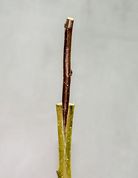The History of the fruit apple and where the cultivation of apple trees started |
|---|
Apples are members of Rosaceae, the Rose family. The apples we know today, varieties of the species Malus domestica, have long been known to have descended from a species of wild apple from central Asia, known as Malus sieversii.
New DNA study confirms this, but also goes further. Malus sieversii grows in both Kazakhstan and Xinjiang in north-west China, but the apples from the two areas differs. Those in Xinjiang are never cultivated. The genes from the apples in Xinjiang are not getting involved in any of the domestic apples. It has been assumed that the Chinese have been growing and propagate apple trees for several thousand years, but from a documentary, broadcast by China Central Television (CCTV) science and education channel, sep 2016 I realised that many Chinese attribute the introduction of the apple to China by John Livingstone Nevius, an American Christian missionary. Livingstone and his wife were said to have brought apple seedings with them around 1860 to Yantai, in Shandong Province, which is now a major apple growing region. Rather, it is in the area between the Euphrates and Tigris cultivation of apple started. |
In The Göbekli Tepe excavation in southern Turkey between the Euphrates and Tigris, it dates before 7500 BC, a seal was found, with 3 signs on it. As I interpret it, it's a snake, a tree and a piece of root. As the snake changes skin, it can be a symbol of resurrection. The tree is resurrected/copied from the root. The first method used to reproduce fruit trees was by root cuttings. They may have propagate apple trees back then There are evidence, that the Sumerians was growing apple trees 2500 BC. |
| Puabi was an Sumerian Queen buried at the city of Ur ca. 2500 BC. Puabi was buried with several servants where the females had headgear with 3 stylized flowers and nekles with leaves. The leaves look like apple leaves, and the flowers could be stylized apple flowers. In the tomb of Puabi was found slices of apples and and among the jewelry small apples in gold. Apples was among Common food for the ordinary Sumerian’s, thats why, there can bee no doubt, that Sumerian was able to propagate apple trees, and the way they did it, in the beginning, was by root cuttings. Se more. Late in the Summerian period, about 2000 BC, the Sumerians invented grafting by approach. Se more. |
When ignoring the gods in the above illustration, it is my interpretation that it is about apples. The stylized tree on the right is a shaped tree for the purpose of grafting by approach. The rootstocks are attached to the tree trunk and tied together with the branches of the tree with a rope. The same kind of tree are seen about 800 BC in the Assyrien time, and appears at other cultures in the region, which shows that the method of multiplying apple trees spread. |
The Romans were enthusiastic apple farmers and brought the apples to the farthest regions of the empire, including Britain. After the decay of the Roman empire, apple cultivation became widespread to northern Europe by Christian monks. |
| Flemming Thorninger, July 17, 2018 |
|
|---|




